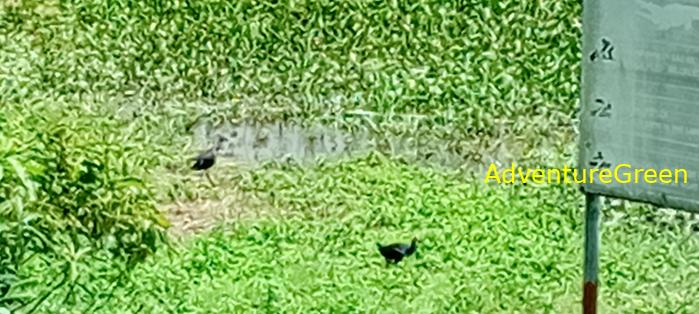Birds of Vietnam, Bird Species in Vietnam

Let's join AdventureGreen on our bird quests to learn about the different birds and bird species in Vietnam. Here you can find out more about the birding spots that these bird species are found.
- Order: Passeriformes
- Family: Turdidae
- Genus: Zoothera
Long-tailed thrush
(Zoothera dixoni, Sáo đất Dixon)
The long-tailed thrush (Zoothera dixoni) is a species of bird in the family Turdidae.
The bird is found from the central and eastern Himalayas to south-central and south-western China.
The genus name Zoothera combines the Ancient Greek zōon meaning "animal" with -thēra meaning "hunter".
- Order: Passeriformes
- Family: Alcippeidae
- Genus: Alcippe
David's fulvetta (Alcippe davidi)
Lách tách má xám
David's fulvetta (Alcippe davidi), endemic to southern China and northern Vietnam, is a species of bird in the family Alcippeidae.
Alcippeidae, Alcippe: Greek Mythology Alcippe, daughter of Aries the god of war.
- Order: Passeriformes
- Family: Alcippeidae
- Genus: Alcippe
Black-browed fulvetta
(Alcippe grotei)
Lách tách mày đen
The black-browed fulvetta (Alcippe grotei) is a 15.5 to 16.5 cm long species of passerine bird in the family Alcippeidae.
This bird species is found in Cambodia, Laos, Thailand, and Vietnam.
Many species of the family Alcippeidae were previously placed in families Pellorneidae or Timaliidae.
Compare:
- Mountain fulvetta (Lách tách vành mắt, Alcippe peracensis): found above 900 m, white eyeing.
- black-browed fulvetta (Lách tách mày đen, Alcippe grotei): found below 400 m, blur or no white eyeing.
Alcippeidae, Alcippe: Greek Mythology Alcippe, daughter of Aries the god of war.
- Order: Passeriformes
- Family: Phylloscopidae
- Genus: Phylloscopus
Limestone leaf warbler
(Phylloscopus calciatilis)
Chích núi đá vôi
The limestone leaf warbler (Phylloscopus calciatilis) is a species of warbler in the family Phylloscopidae.
The name combines the Ancient Greek phullon meaning "leaf" and skopos meaning "seeker" (from skopeo, "to watch").
calciatilis: Inhabiting in limeston evironment.
calci (L). The heel; lime, lime- stone calcitr.
-atilis (L) indicates place of growth (saxatilis = growing among
rocks.
- Order: Passeriformes
- Family: Corvidae
- Genus: Urocissa
White-winged magpie
(Giẻ cùi vàng, Urocissa whiteheadi)
The white-winged magpie or Hainan magpie (Urocissa whiteheadi) is a passerine bird of the crow family, Corvidae.
Corvina ( Coracina) / corvina Latin corvinus raven-like, raven-black (corvus raven).
The name Urocissa combines the Ancient Greek oura meaning "tail" and kissa meaning "magpie" .
- Order: Strigiformes
- Family: Strigidae
- Genus: Strix
Spotted wood owl (Hù phương đông, Strix seloputo)
The spotted wood owl (Strix seloputo) is an owl of the earless owl genus, Strix.
Strigidae: The family for all Owls except Barn Owls, derived from "Strix", a Latin word for owl (also the same in Greek).
seloputo Javanese name Selo-puto for the Spotted Wood Owl (Strix).
- Order: Strigiformes
- Family: Strigidae
- Genus: Strix
Brown wood owl
(Hù, Strix leptogrammica)
The brown wood owl (Strix leptogrammica) is found in India, Bangladesh, Sri Lanka, Indonesia, Taiwan, and south China.
Strigiformes: All Owls are classified as members of this order. The name is formed from "Strig", the plural form of the Latin word "strix", meaning "owl" and "formes", meaning "forms".
Strigidae: The family for all Owls except Barn Owls, derived from "Strix", a Latin word for owl (also the same in Greek).
leptogrammica:
Lepto- comes from the Greek leptós, variously meaning “thin, slight, fine, small,” with a literal sense of “stripped.”
grammikos linear, lined.
γρᾰμμή (grammḗ, “a stroke or line of a pen”, “a line as in mathematical figures”) + -ῐκός (-ikós, “of or pertaining to”, “in the manner of”).
- Order: Accipitriformes
- Family: Accipitridae
- Genus: Nisaetus
Changeable hawk-eagle
or crested hawk-eagle, marsh hawk-eagle or Indian crested hawk-eagle
(Diều đầu nâu, Nisaetus cirrhatus)
The changeable hawk-eagle (Nisaetus cirrhatus) or crested hawk-eagle is a large bird of prey species of the family Accipitridae.
"Changeable" is from a wide variation of plummage: from pale to dark, varying on molt and age change.
Accipitridae from Latin accipiter/accipitri- "hawk".
The genus name Nisaetus combines the Medieval Latin nisus for a sparrowhawk with the Ancient Greek aetos meaning "eagle".
The specific epithet cirrhatus is from Latin cirratus meaning "curly-headed".
- Order: Accipitriformes
- Family: Accipitridae
- Genus: Nisaetus
Mountain Hawk-Eagle
or Hodgson's hawk-eagle
(Diều núi, Nisaetus nipalensis)
The mountain hawk-eagle (Nisaetus nipalensis) or Hodgson's hawk-eagle, is a large bird of prey native to Asia.
Accipitridae from Latin accipiter/accipitri- "hawk".
The genus name Nisaetus combines the Medieval Latin nisus for a sparrowhawk with the Ancient Greek aetos meaning "eagle".
- Order: Passeriformes
- Family: Pellorneidae
- Genus: Pellorneum
Spot-Throated Babbler
(Chuối tiêu họng đốm, Pellorneum albiventre)
The spot-throated babbler (Pellorneum albiventre) is a species of bird in the family Pellorneidae.
Pellorneidae, Pellorneum: the Ancient Greek pellos meaning "dark-coloured" with orneon meaning "bird".
albiventre: Latin albi: white; ventre: Latin venter (“the belly; the womb; a swelling”).
- Order: Strigiformes
- Family: Strigidae
- Genus: Ketupa
Spot-bellied eagle-owl
also known as the forest eagle-owl
(Dù dì Nêpan, Ketupa nipalensis),
The spot-bellied eagle-owl (Ketupa nipalensis), also known as the forest eagle-owl is a large bird of prey with a formidable appearance.
Strigidae: derived from "Strix", a Latin word for owl (also the same in Greek).
Ketupa: From specific name Strix ketupu.
nipalensis: Nepal.
- Order: Passeriformes
- Family: Turdidae
- Genus: Zoothera
Long-billed thrush
(Zoothera monticola)
The long-billed thrush (Zoothera monticola) is a species of bird in the family Turdidae.
The bird is found from the Himalayas to Myanmar and Vietnam.
The genus name Zoothera combines the Ancient Greek zōon meaning "animal" with -thēra meaning "hunter".
Monticola, monticolus, monticole is the Latin word for mountain-dweller or mountaineer.





































